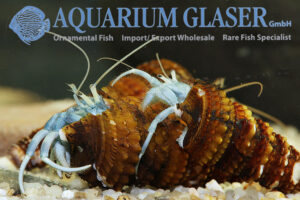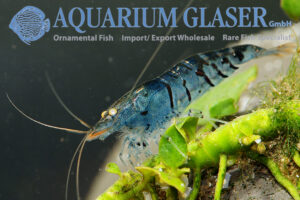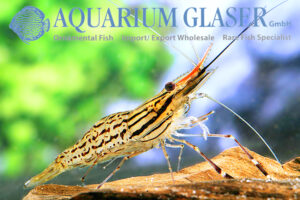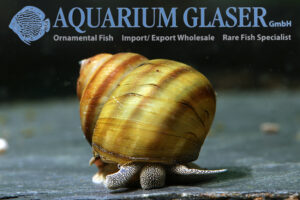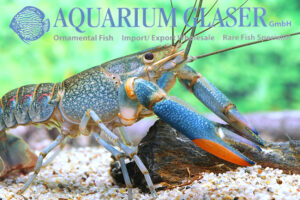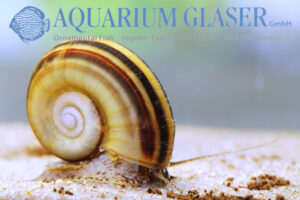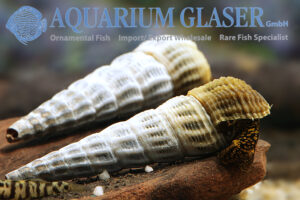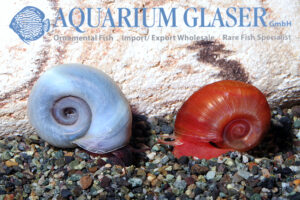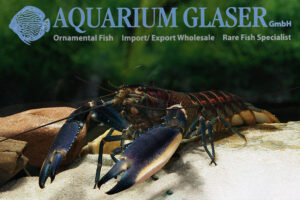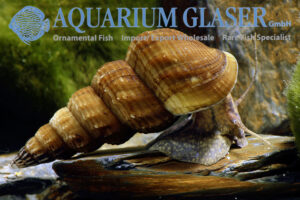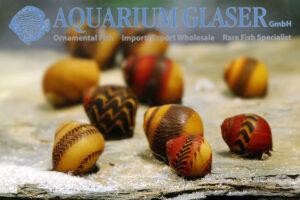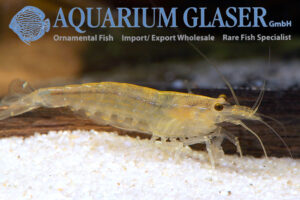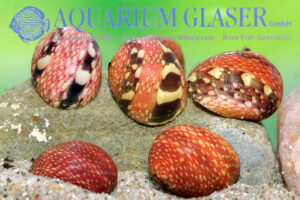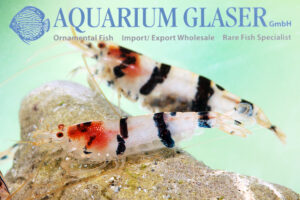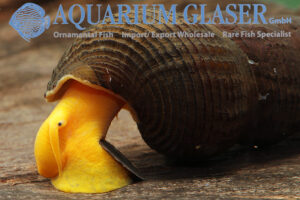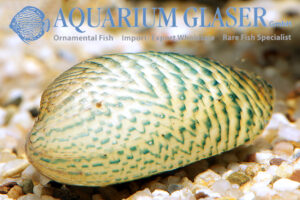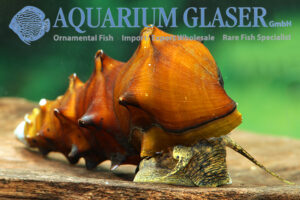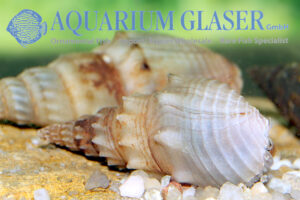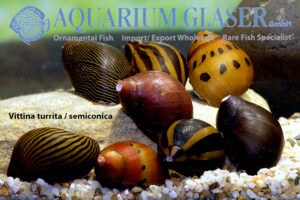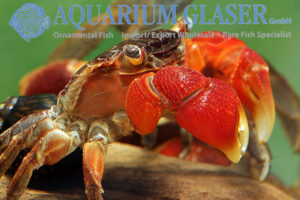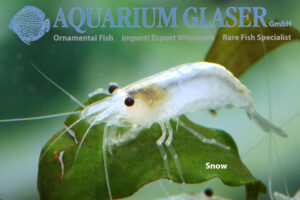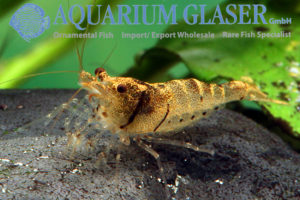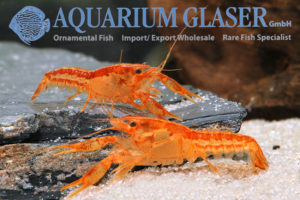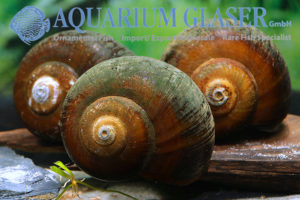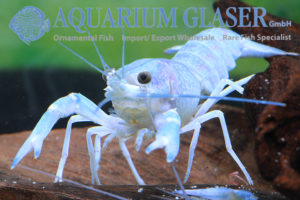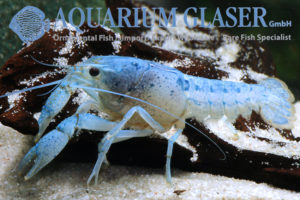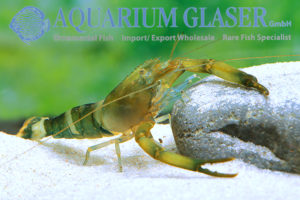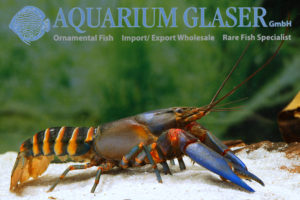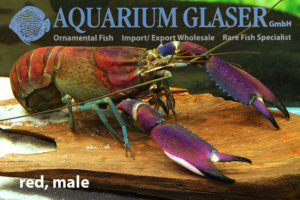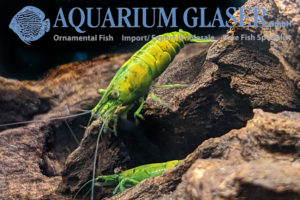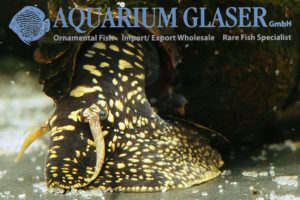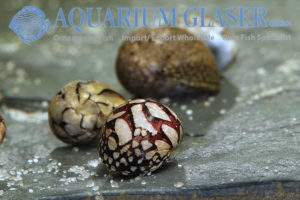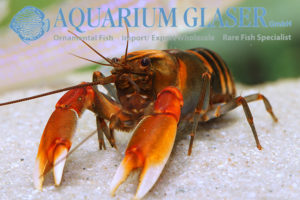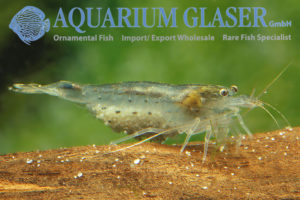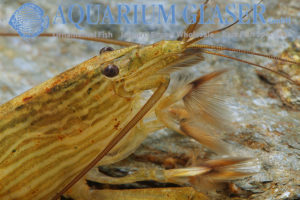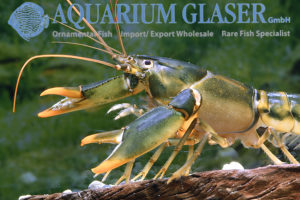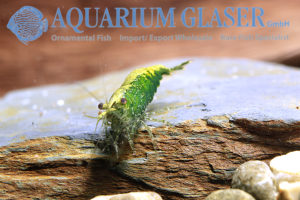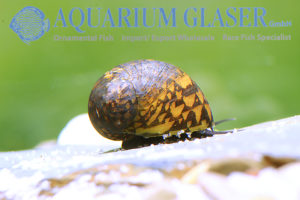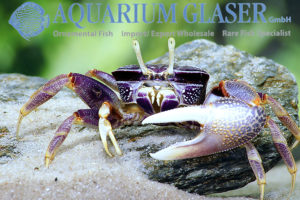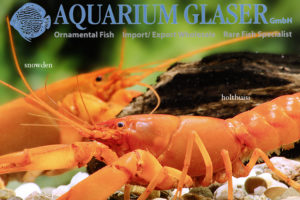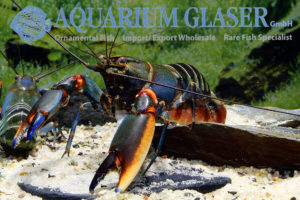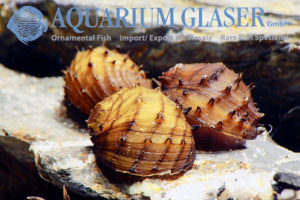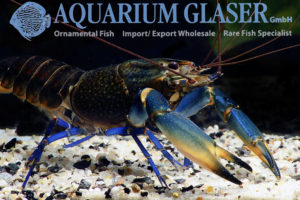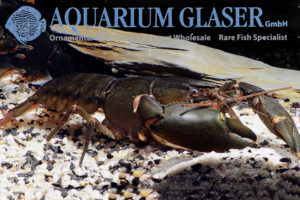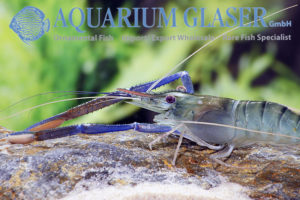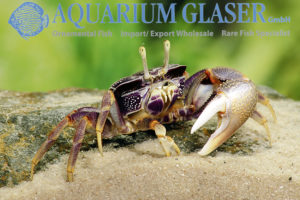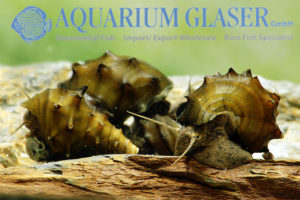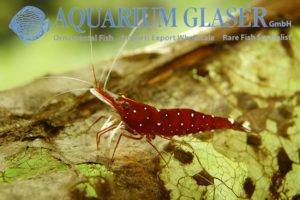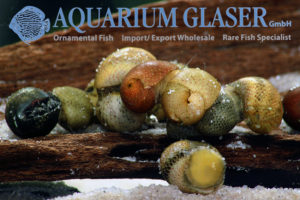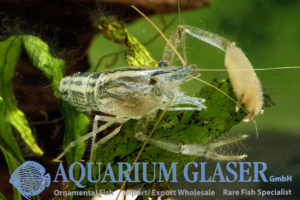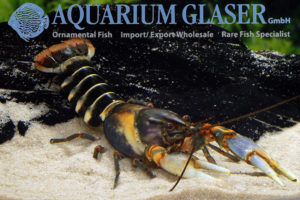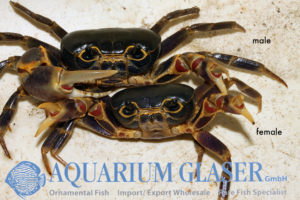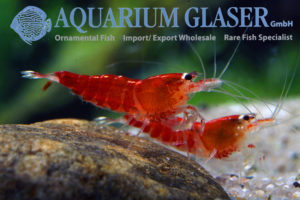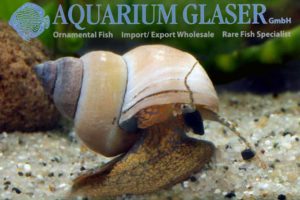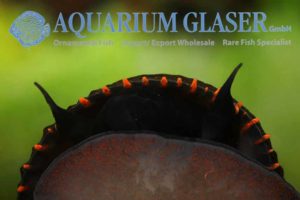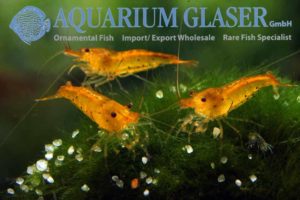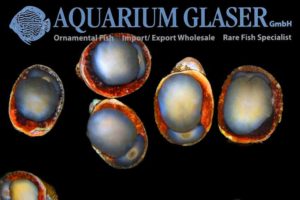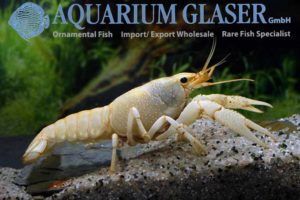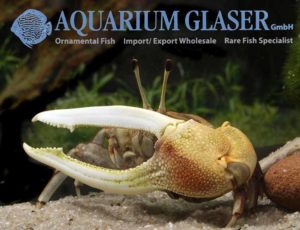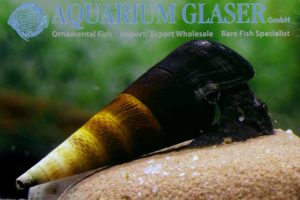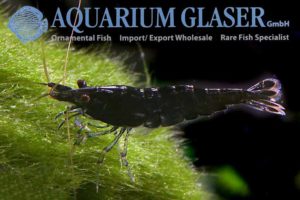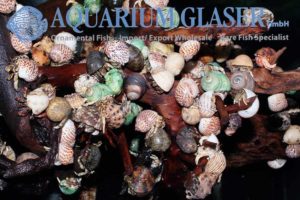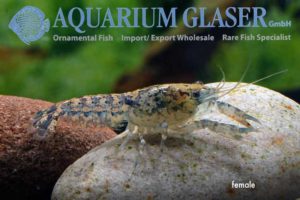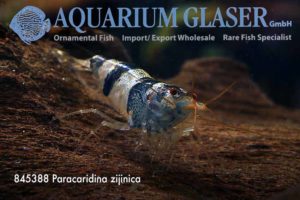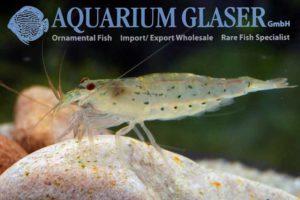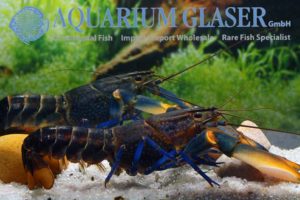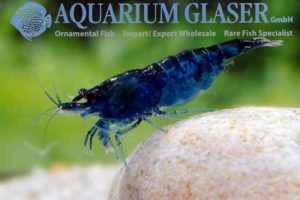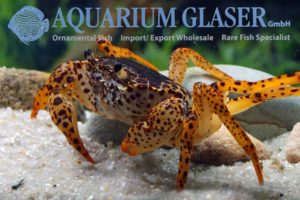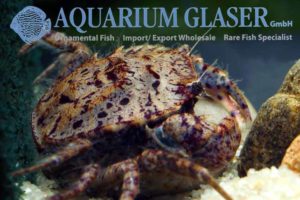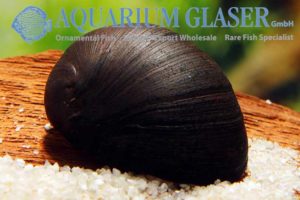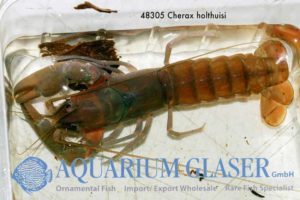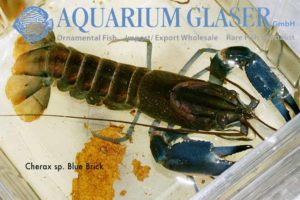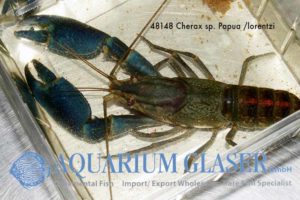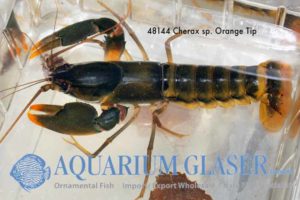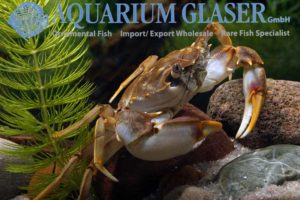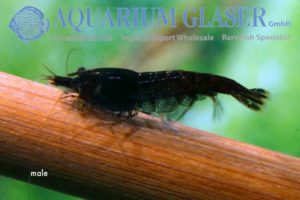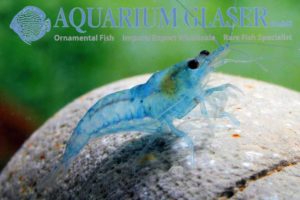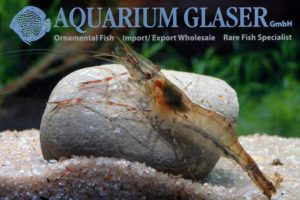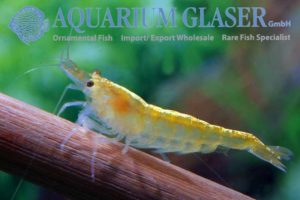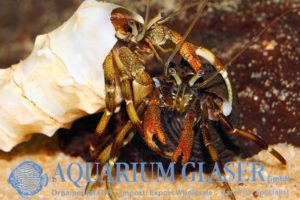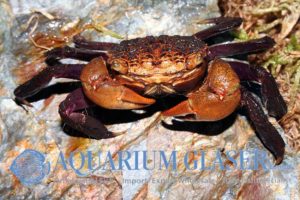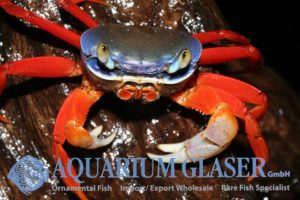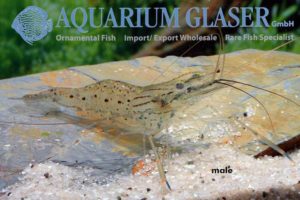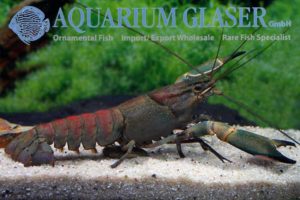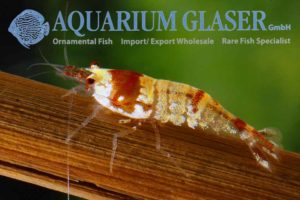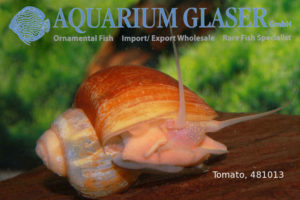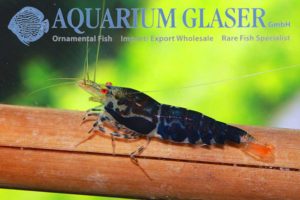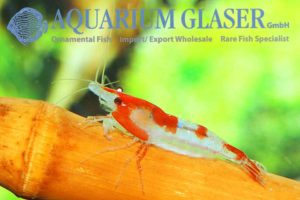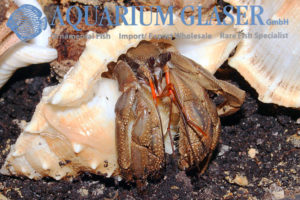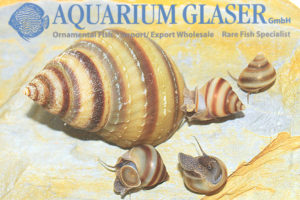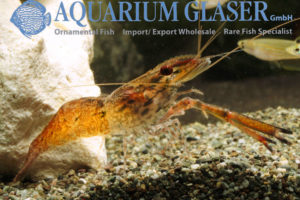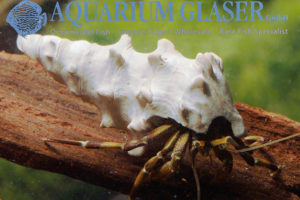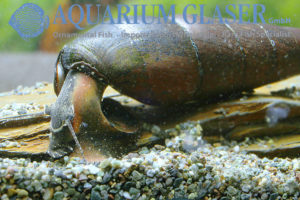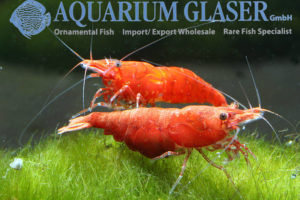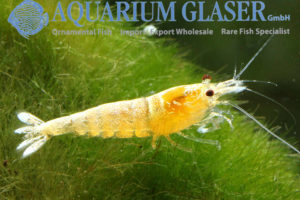The cute hermit crab Clibanarius africanus has become a popular invertebrate. It is a euryhaline animal, which means that it can live in both pure freshwater and pure seawater. However, the life expectancy in pure freshwater seems to be limited to a few months, which is why it is better to keep the animal in […]
31. Crayfishes, Shrimps, Crabs, Snails, Mussels (149)
-
-
Caridina mariae Deep Blue Tiger Yellow Eyes ( = Neocaridina sp. Tiger)
Tiger shrimps were among the first dwarf shrimp species to enter the hobby around 30 years ago. At that time, they were still simply numbered, the “Tiger” was Caridina or Neocaridina sp. V. Only specialists can clarify the genus affiliation of dwarf shrimps, there are no recognizable characteristics on live animals. In 2015, Klotz & […]
-
Macrobrachium spinipes
Macrobrachium rosenbergii is the largest and therefore frequently bred large-armed shrimp in aquaculture for food purposes. We have this impressive species more or less regularly in our program for specialists and show aquariums. For the biology and pictures of this species, see https://www.aquariumglaser.de/en/31-crayfishes-shrimps-crabs-snails-mussels/macrobrachium-rosenbergii-3/ M. spinipes is closely related to M. rosenbergii and has often been […]
-
Viviparus viviparus
Among the freshwater snails native to Central Europe, three species play a special role due to their considerable size (4 cm and larger): the ramshorn snail, the great pond snail and the river snail. At least in the case of the latter – the river snail – the specific article “the” river snail is actually […]
-
Cherax quadricarinatus
Among the numerous Cherax species Cherax quadricarinatus, also known as Australian red claw crayfish, occupies a special position. It has been propagated as edible crayfish in aquaculture for decades and was therefore one of the very first Cherax species available for aquaristics. Cherax quadricarinatus belongs to the largest representatives of its genus, males can reach […]
-
Marisa cornuarietis
Marisa cornuarietis, originally from Colombia, is one of the largest freshwater snails kept in the aquarium. Its disk-shaped shell can reach over 5 cm in diameter. This is why the species has been continuously kept in aquariums since the 1930s, although it is only suitable for special aquariums without plants. Sooner or later every aquatic […]
-
Tylomelania marwotoae
Although in aquaristics the scientific names are usually chosen for communication and only very few species have a really common or international popular name, there seems to be an occasional need for such popular names. However, in the case of the snail Tylomelania marwotoae, which originates from a single lake on Sulawesi – Lake Mahalona, […]
-
Planorbella duryi
Ramshorn snails have been popular since the beginning of aquaristics (around 1850), as they consume algae and eat leftovers, but usually leave the plants alone. In addition, as lung breathers, they are not additional oxygen consumers. In the past, it was natural to have the native species Planorbarius corneus in the tank, which coped very […]
-
Cherax warsamsonicus (= sp. Hoa Creek)
A species of Cherax that is quite popular in the hobby for at least a decade (we are aware of imports since 2008) is Cherax sp. „Hoa Creek“, sometimes also called C. sp. „Irian Jaya“ or C. sp. „Red Coral“. The exact origin of these crayfish was totally unknown. They appeared in the market often […]
-
Brotia herculea
The specific name „herculea“ says it all: it is loaned from Hercules, the divine hero of the Greek mythology who had enormous powers. This snail attains a length of almost 10 cm! So the common name „Giant Tower Cap Snail“ is more than justified. The snail occurs naturally in Burma and Thailand where it inhabits […]
-
Vittina waigiensis
If there was a beauty contest between the nertine snails: the species commonly known in the hobby as Neritina or Vittina waigiensis would certainly be among the winners! This species, which reaches a shell diameter of 1.5-2 cm and has extremely variable markings, was originally described by Lesson in 1831 as Neritina waigiensis. The animals […]
-
Caridina multidentata “Yellow”
After the new breeding forms “Snow” and “Orange” (https://www.aquariumglaser.de/en/31-crayfishes-shrimps-crabs-snails-mussels/caridina-multidentata-orange-and-snow/), the Asian professional breeders have now apparently established a third color form of the Amano shrimp: “Yellow”. The yellow Amano shrimp (zoologically speaking, all Amano shrimps belong to the same species, namely Caridina multidentata) also has no care requirements that differ from the original form. All […]
-
Clithon sowerbianum “Pink Lady”
Like most neritine snails, Clithon sowerbianum, known as the mini neritine snail, is extremely variably colored. As early as the 19th century, a number of variants were therefore scientifically named, but these are no longer considered to be of systematic importance. However, it must be clearly stated that the identification of the 57 accepted Clithon […]
-
Caridina haivanensis
Dwarf shrimps of the genera Caridina, Paracaridina and Neocaridina have become an integral part of the aquarium hobby. In countless wild species, color variants and cultivated forms, they delight nature lovers all over the world. It is hard to believe that these little animals were practically unknown in the hobby 30 years ago! Parallel to […]
-
Tylomelania sp. “Pure Orange”
Not only beautiful dwarf shrimps come from Lake Poso on Sulawesi (formerly: Celebes), but also these large cousins of the well-known tuberculate snail (Melanoides tuberculata). The bright color of the soft bodies of this Tylomelania, which is apparently a scientifically undescribed species, is particularly striking; occasionally the name Tylomelania scalariopas is used for them, but […]
-
Scabies crispata
We have imported this pretty small freshwater mussel from Thailand again now. The species has a wide distribution in Asia. It is recorded from Thailand, Cambodia, Vietnam, India and China. Nevertheless very little is known about the species. Scabies crispata is a member of the Unionidae family. The central european large freshwater mussels of the […]
-
Brotia pagodula
This very attractive snail species reaches us from Southeast Asia. Brotia pagodula is a viviparous snail that is endemic to the Moei, a border river between Myanmar and Thailand. The shell of this species becomes 4-5 cm long. The species is sexually separate, but the sexes are not externally distinguishable. Its strongly coiled shell with […]
-
Thiara winteri
The pretty Thiara winteri from Indonesia with its pagoda-like shell, the longitudinal ribs of which are more or less (this varies greatly from individual to individual) spiky at the junctions of the coils, belongs to the group of trumpet snails relatives to which, for example, also belongs the very common red-rimmed melania (Melanoides tuberculata). The […]
-
Vittina turrita and V. semiconica
The nerites (Neritidae), also known as racing snails, are very popular. Their beautiful coloration is one of the reasons for this, but also their excellent properties as algae cleaners, which (if you keep enough specimens) reliably keep the aquarium glass clean. Plants, on the other hand, are left completely alone. And there is no unwanted […]
-
Manarma moeschii ( = Pseudosesarma moeschii)
The red mangrove crab or red Thai crab is by far the most popular crab for paludaria (combined aquaria and terraria). What is not yet widely known is that it was placed in a different genus – Manarma – in 2020. In the hobby, the species name is also traditionally misspelled. The correct name is […]
-
Caridina multidentata Orange and Snow
The Amano shrimp, Caridina multidentata (formerly: C. japonica) is the most popular of all aquarium shrimps. However, it is only available seasonally from wild collections. However, as there is a year-round demand, the species is bred on a large scale. For German offspring, see here: https://www.aquariumglaser.de/en/31-crayfishes-shrimps-crabs-snails-mussels/amano-shrimp-now-also-available-as-german-offspring/ When animals are bred, sooner or later color or […]
-
Caridina pareparensis parvidentata
Dwarf shrimp from the island of Sulawesi (formerly: Celebes) in Indonesia are famous for their colorfulness – and notorious for their high demands on care. These species originate from the large Malili lakes. However, there are dwarf shrimp on Sulawesi that are some of the easiest to keep and maintain anywhere! Among these is Caridina […]
-
Cambarellus patzcuarensis CPO
The gray-brown wild form of the orange dwarf crayfish Cambarellus patzcuarensis (CPO) originates from Mexico, where it is endemic (i.e. only found there) in Lake Patzcuaro. Due to massive environmental pollution and the use of foreign fish for food purposes, the ecosystem of Lake Patzcuaro is extremely disturbed, and a large number of the animal […]
-
Pila ampullacea
Since November 8, 2012, a ban on apple snails of the genus Pomacea has been in effect in the EU, because one of the species has been found to be a pest in rice plantations in Portugal. Since then, apple snails may not be passed on (not even given away!) even if they are offspring […]
-
Cherax quadricarinatus
Among the numerous Cherax species Cherax quadricarinatus, also known as Australian red claw crayfish, occupies a special position. It has been propagated as edible crayfish in aquaculture for decades and was therefore one of the very first Cherax species available for aquaristics. Cherax quadricarinatus belongs to the largest representatives of its genus, males can reach […]
-
Procambarus alleni
Among the numerous species of North American crayfish, Procambarus alleni, under the name “Blue Florida Lobster”, has for many years been a fixture in the aquarium trade. However, one must know: although breeders prefer to breed with blue specimens and usually only blue animals are sold, this is by no means a species characteristic. There […]
-
Macrobrachium agwi Candy Shrimp
Many species of animals and plants have been discovered only because they were imported for the purpose of keeping them alive. This is very important, because species knowledge is the absolute basic requirement for species protection. You cannot protect a species that you do not know. In the north of India, in the district of […]
-
Cherax peknyi Super Blue
We have received a beautiful color variation of the zebra crayfish from New Guinea, which is characterized by deep blue claws. These are quite magnificent animals! For basic information about the species see https://www.aquariumglaser.de/en/fish-archives/cherax-peknyi-4/ For our customers: the animals have code 483025 on our stocklist. Please note that we only supply wholesale. Text & photos: […]
-
Cherax wagenknechtae (= Red Brick)
The colorful New Guinea crayfish of the genus Cherax have revolutionized aquaristics in some ways. Before their aquaristic discovery in the late 1990s, large crayfish in the aquarium were more a matter for specialists. They were considered formidable plant destroyers, tireless burrowers, and at night they would eat sleeping fish. These are all attributes, with […]
-
Neocaridina denticulata Hulk orange
The Hulk is a comic character from the Marvel universe, a strong, green colored fellow with high destructive potential. We assume that the new dwarf shrimp Neocaridina denticulata Hulk orange, which we could now exclusively import from Taiwan for the first time, is called Hulk because of its green main coloration, because you can hardly […]
-
Tylomelania towutensis
The snails of the Malili Lakes on Sulawesi (formerly: Celebes) belonging to the family Pachychildae are great animals to keep for their own sake and not just as useful algae and debris eaters, like many other snails. All Tylomelania species of the region have in common that they occur in warm (around 30°C), soft and […]
-
Vitta virginea ( = Neritina virginea)
The Nerites, also known as racing snails (family Neritidae), are distributed worldwide in warm and temperate zones. They have an operculum at the foot that allows them to close the shell completely, a cup-shaped shell, and they are often strikingly brightly colored. Many tropical species colonize uppermost shore areas and can live in both seawater […]
-
Cherax peknyi
Once again we were able to import zebra crayfish. These crayfish experienced some name changes due to the fact that the freshwater crayfishes of New Guinea were little known prior to their aquaristic discovery. The animal originally entered the trade as Cherax misolicus, but it was thought to be more likely C. papuanus. Its valid […]
-
Amano shrimp now also available as German offspring
The Amano shrimp (Caridina multidentata, formerly known as C. japonica) is one of the most popular freshwater shrimp for the aquarium. It feeds on Aufwuchs, eg microorganisms and is therefore absolutely harmless to fish and plants. Instead, through its grazing activity, it frees plants and decoration from annoying algae growth or ensures that algae do […]
-
Atyopsis moluccensis
Among the numerous shrimp species that have gained a firm foothold in the hobby are two larger species of fan shrimp, namely Atyopsis moluccensis, the Moluccan mountain rock shrimp from Southeast Asia, and Atya gabonenis, the Gabon giant fan shrimp from West Africa. They grow relatively large (A. moluccensis approx. 9 cm, A. gabonensis approx. […]
-
Cherax snowden
The diversity of the crayfishes of New Guinea is hard to keep track of. Most difficult is the decision, whether a freshly imported form is a color variant of a long known species or a new species; because the color variance within the species is enormous. Cherax snowden was known as Cherax sp. “Orange Tip” […]
-
Neocaridina davidi Jade Green
The “universal dwarf shrimp for all occasions” also comes in green: Neocaridina davidi Jade Green. Indeed, some of the animals shine quite unbelievably, the comparison with Jade is in this case no flowery exaggeration. In terms of care and breeding, the dwarf shrimps are no different from their different-coloured conspecifics. For our customers: the animals […]
-
Neritodryas cornea
From Thailand we have received pretty snails under the name Neritina coromandeliana. Whether such names are correct, we usually cannot decide, as we have only ichthyologists (= biologists specialized in fish) in our team. Many German snail experts believe that these animals, which are characterized by their zigzag pattern and yellow triangles on a dark […]
-
Afruca (formerly: Uca) tangeri
The eastern Atlantic from Portugal to Angola, is the origin of the fiddler crab Afruca tangeri, where it inhabits sand and mangrove coasts. We obtain the animal from Nigeria. The to an enormous size grown major claw of the males is remarkable. It is used for attracting the females and for the fight between rivaling […]
-
Cherax snowden “Irianto Red” and Cherax holthuisi
These intensively colored crayfish originate from Papua New Guinea, where they are found on the Vogelkop Peninsula. „Irianto Red” is a colour variant of the Cherax snowden, which was only scientifically described in 2015, while Cherax holthuisi already received its scientific name in 2006; before that, C. holthuisi was known as “apricot crayfish“, while C. […]
-
Cherax alyciae “Blue Kong”
This crayfish was regarded as a particularly pretty variant of the zebra-lobster (Cherax peknyi) until recently and was called “Blue Kong” in the trade melodiously. Chris Lukhaup, Rury Eprilurahman and Thomas von Rintelen described it scientifically as Cherax alyciae in June 2018. We have just received these very attractive animals as wild catches from Indonesia. […]
-
Neritina juttingae
The Neritina snails are enjoying growing popularity among aquarists. There are several reasons for this. The most important one is certainly that they look attractive. In addition, Neritina snails do not reproduce in freshwater aquariums, as the larvae only develop in the sea. The third important reason for the popularity is that Neritina snails also […]
-
Cherax sp. Blue Moon Black Body / Black Scorpion Blue Leg
The variety of colours of the crayfish on New Guinea is really amazing. In the trade it is often problematic to assign the import animals exactly to any species, because the colouring is also very variable within the species and only rarely all specimens of an import look the same. Be that as it may: […]
-
Cherax sp. „Black Scorpion“
Along with other species of Cherax,, which we have already introduced to you, we have received the Cherax sp. “Black Scorpion”. They are very attractive animals whose care and breeding does not differ significantly from that of the previously known Cherax forms from New Guinea. For our customers: The animals have code 481473 on our […]
-
Macrobrachium rosenbergii
The largest species of freshwater shrimp at all is Macrobrachium rosenbergii. Males of the species can reach a length of 50 cm (inclusive the long arms), as is shown by the specimens we photographed years ago on a food marked in Thailand. Despite that enormous size the species does not get old. Scientific research found […]
-
Uca tangeri
The eastern Atlantic from Portugal to Angola, is the origin of the fiddler crab Uca tangeri, where it inhabits sand and mangrove coasts. We obtain the animal from Nigeria. The to an enormous size grown major claw of the males is remarkable. It is used for attracting the females and for the fight between rivaling […]
-
Brotia armata
Currently we can offer several species of the livebearing snails of the genus Brotia from Thailand. These snails are no hermaphrodites like many other snails, but the sexes cannot be told apart from external features. However, Brotia will never become a plague like many other snails do. They feed on algae and other Aufwuchs. Water […]
-
Caridina dennerli
When the White Spot Bee Shrimp appeared about 10 years ago for the first time in larger numbers in the ornamental fish trade we all where really enthusiastic about them. Sadly we had to learn that the tiny animals are very sensitive against temporary distress, for example low temperatures during transportation, and die very quickly […]
-
Nerita polita
We obtained the charming algae snail Nerita polita from Thailand. This „racing snail“ is also known by the popular name of Polished Nerite. It inhabits large parts of the Indo-West-Pacific and is extremely common. It was described scientifically as early as 1758, the year of birth of the scientific naming of organisms, by Carl von […]
-
Macrobrachium scabriculum
We have obtained once more beautiful chameleon shrimps (Macrobrachium scabriculum) from India. The common name for that species has been given by Uwe Werner due to the change of the basic coloration during the life. Initially these shrimps are translucent, then they usually become blueish, then brownish and finally almost black. Only the contrasting stripe […]
-
Cherax peknyi
Finally we were able to import once more zebra lobsters. These crayfish had several changes in respect of the determination, because the freshwater crayfish from New Guinea were hardly know prior to their discovery as aquarium inhabitants. Initially they were imported under the name of C. misolicus, but it was guessed they might be closer […]
-
Laevimon kottelati
We were able to import some specimens of the freshwater crab Laevimon kottelati. This interesting an beautiful crab attains a size of about 4.5 cm Carapax-width aund existis endemicly in Vietnam. Here it has been discovered in 1998 and decribed scientifically in 2005 as a new species in a new genus. It lives amphibic in […]
-
Caridina logemanni Crystal Super Red Cologne Strain
Since the very first start of breeding sports in ornamental fish some strains were named after the tow they appeared first. Examples are the „Vienna Emerald Guppy“, the „Hamburg Swordtail“, or the „Bristol Shubunkin“. This tradition also took place in dwarf shrimps and so a „cologne strain“ of Caridina logemanni exists. We now obtained a […]
-
Filopaludina (Siamopaludina) martensi cambodjensis
For the first time ever we were able to import this pretty snail from Thailand. It is a typical viviparid snail that shares all the characters of the family: these animal breath via gills, not via lungs, and thus use the dissolved oxygen in the water for breathing, like fish do; there are males and […]
-
Paludomus loricatus
Among the most unusual species of freshwater snail is the Red Spotted Bella Snail, Paludomus loricatus, from Sri Lanka. The eyes of this snail are very attractive coloured, brightly red-orange. Around the mantle are numerous folds of the same colour. We are informed on the biology of P. loricatus by Starmühlner (Starmühlner, F. (1974): The […]
-
Neocaridina sp. Golden Tiger
This is the latest star in our stocklist: are real pretty little creature! The animals are German bred ones, available in very limited numbers only! For our customers: the shrimps have code 485472 on our stocklist. Please note that we exclusively supply the wholesale trade. Text & photos: Frank Schäfer
-
Neritina violacea, Red Lip Snail – new in stock
The snails of the genus Neritina have become very popular among aquarists. These snails are excellent algae eaters. They feed most algae from the glasses of the tank, because they prefer hard surfaces to live on. Another advantage of these snails is that they cannot breed under aquarium conditions, because the larvae develop in marine […]
-
Procambarus clarkii White
The Louisiana crayfish (Procambarus clarkii) has become a real domesticated pet. Quite a lot of colour sports have been developed by breeders. These sports do not exist in the wild. One of these sports is plain white. In case the female bears eggs it looks like Snow White playing with snowballs… Sadly the species P. […]
-
Uca vocans
Fiddler crabs are always something very special. They live along the border of water and land. During the tide they hide in wholes in the sand. At low water the come out of their hiding places and search for food that the water left behind. The males display their mighty claw to impress the females, […]
-
Faunus ater CAPUCCINO
This attractive, about 6 cm long snail currently reached us from Indonesia. It is a relative of the well known Malayian trumpet snail. In the wild this animal occurs in the lowest reaches of rivers on muddy bottoms and is thus very tolerant against salt. So it is possible to keep it in freshwater tanks […]
-
Neocaridina davidi Black Choco Shrimp
The most popular and easy to keep dwarf shrimp for the freshwater aquarium, Neocaridina davidi, has another new dress: pitchblack! Of course there do exist already black sports of other species of dwarf shrimp, but N. davidi has against other species the big advantage that N. davidi is extremely tolerant against different temperatures. Other species […]
-
Coenobita rugosus
From Taiwan we were able to import beautiful land hermits. They belong to the species Coenobita rugosus, which can be recognized by the ridge-like swellings on the upper edges of the claws. The colour is very variable and can be grey, brown or reddish. Like all Coenobita species the animal likes to live in groups. […]
-
Cambarellus diminutus
We received nice bred specimens of this tiny species from Indonesia. Initially Cambarellus diminutus originates from North America, where it occurs along the Gulf of Mexico. In contrast to the larger species of crayfish, the species belonging to the genus Cambarellus fit perfectly for community tanks. C. diminutus is the smallest species of all and […]
-
Mustang shrimps arrived!
For the first time we can offer the very pretty, black-and-white “Mustang Shrimp”. The dwarf shrimps belong – according to the “godfather of dwarf shrimps”, Werner Klotz – to the species Paracaridina zijinica. Regarding keeping and breeding they do not differ from the well known dwarf shrimp “Crystal Red”. By the way: this species of […]
-
Atyoida pilipes
Dwarf shrimps are charming and completely harmless, but also very small. So keepers of somewhat larger fish often search for a species of shrimp which is absolutely harmless and day active, but also a bit larger – too large to be eaten as an intermediate snack between dinner and supper. For these cases mother nature […]
-
Cherax sp. Blue Moon
We obtain a number of very beautiful species of the genus Cherax from New-Guinea. One of them is the “Blue Moon”, which is not yet determined on a scientific basis. The legs are bright blue and the carapax is of a deep midnight blue. The outer ridge of the claw is bright yellow-orange – this […]
-
Neocaridina davidi Fantasy Jelly
The development of new colour sports in dwarf shrimps still goes on and on. The latest brandnew sport reached us now from Taiwan under the name of Fantasy Jelly. This pretty animal is of a deep, intense royal blue; the colour is so intensive that the shrimps sometimes even look black. Possibly this new sport […]
-
Panther crabs from Sulawesi
The Panther crabs (Parathelphusa pantherina) are for sure the most attractive of all freshwater crabs. They originate from Matano lake in Sulawesi, where they can be also found under roots etc. on the shore. The animals are, like almost all crabs, omnivorous. However, most food items taken are from animal origin. The maximum width of […]
-
Trichodactylus sp. Paraguay
Crabs are the personalities among the crustaceans. The crabs of the genus Trichodactylus are exclusive freshwater crabs. These crabs are like most other crabs omnivorous and don´t stop for plants or tankmates. The crabs are not mean, they simply try everything wether it tastes or not. So one should keep the funny guys best in […]
-
Neritina pulligera
We received a nice shipment of the Pitchblack racing snail Neritina pulligera. Like its close relative, the Zebra snail Neritina turrita, this snail is a excellent algae eater. The species does not breed in the aquarium. Our experience with that snail is that they don´t leave the water, in contrast to other species of the […]
-
Cherax holthuisi
code: 483051
-
Cherax sp. Brillant Pink / Blue Brick
code: 481488
-
Cherax sp. Papua/Lorentzi
code: 481482
-
Cherax sp. Orange Tip
code: 481442
-
Platythelphusa armata
Lake Tanganyika in Africa is a kind of very large aquarium. Hundreds of endemic species – endemic means that they occur only there and nowhere else in the world – live in Lake Tanganyka. This week we have some specialities from the lake for you. First: Platythelphusa armata. This is one of nine species of […]
-
Neocaridina heteropoda (davidi) Black
Code 485201
-
Neocaridina heteropoda Sushi Blue
Neocaridina heteropoda is for sure the most popular of all dwarf shrimps; probably one must learn a new name for it, as it seems as if the name heteropoda is a junior synonym to the name davidi. But despite the name, may it be heteropoda or davidi: the dwarf shrimp scene is unthinkable without that […]
-
Macrobrachium brasiliense Paraguay
For the first time we could import this species of shrimp from Paraguay. Most probably it represents a population of Macrobrachium brasiliense. That species was imported by us ocassionally already from Peru (see http://www.aquarium-glaser.de/en/archiv.php?news_id=299). Compared with the Peruvian specimens those from Paraguay have more slender arms, otherwise they look identical. The maximum length of our […]
-
Neocaridina heteropoda Yellow
The dwarf shrimp Neocaridina heteropoda is one of the most easy to keep dwarf shrimps. It is absolutely undemanding regarding water chemistry and tolerates water temperatures between 10 and 30°C. Moreover it is very easy to breed. The species attains a maximum length of about 3 cm and is a perfect aquarium animal. Neocaridina heteropoda […]
-
Clibanarius africanus
The charming hermit crab Clibanarius africanus has become a very popular aquarium inhabitant. It is an euryhalin species, which means that it can survive in both pure fresh and pure marine water. However, it seems that it can live in pure freshwater only for a few months, so it is much better to keep it […]
-
Perisesarma huzardi
This crab is something like the big sister of the “classical” Red Mangrove Crab, Pseudosesarma moeschi. Regarding keeping that crab no major differences exist to that of the smaller relative with the exception that P. huzardi becomes as twice as large – about 8 cm carapax width. So the species needs bigger and more spacious […]
-
Cardisoma armatum
From the coasts of West and Central Africa originates Cardisoma armatum. The bright orange colored legs form a strong contrast to the blue body and let this crab become an attractive ornament. With a carapax diameter of approximately 10 cm it does not belong to the smallest crabs, therefore a spacy tank has to be […]
-
Macrobrachium sp. Red Spot
We received from India (West Bengal) this attractive species of Macrobrachium, which we could not apply to any described species so far. For our customers: the animals have code 484733 on our stocklist. Please note that we exclusively supply the wholesale trade. Text & photos: Frank Schäfer
-
Cherax sp. Papua
This Cherax represents in all probability a still undescribed species. We received a small number of the attractive animal from Papua New Guinea. The crayfish are very pretty due to the rusty red spots on the back. The animal can be kept along with fish, but feeds often on plants. For our customers: the crayfish […]
-
Caridina sp. Mosura Shrimp
We received a shipment of this extremely charming sport of the Crystal Red or Red Bee Shrimp from Indonesia. For our customers: the animals have code 485358 on our stocklist. Please note that we exclusively supply the wholesale trade. Text & photos: Frank Schäfer
-
Apple Snails in many colours
Currently we can offer Apple Snails in many interesting colours. These beautiful snails are easy to keep and can get a size of about 5 cm in diameter. In the aquarium, they should be fed regularly like fish, for Apple Snails are heavy feeders and cannot survive with the remains of the fish only. There […]
-
Caridina “Black Tiger Yellow Eyes”
The black tiger shrimp is a cultivated variety of the tiger shrimp that originates from southern China. The tiger shrimp itself is a very variable species and possibly belongs to the species described as Caridina cantonensis. The bright shining eyes and the fantail in the same colour are very characteristic for the animal. We have […]
-
Neocaridina heteropoda RILI
The Cherry red shrimp belongs to the most popular dwarf shrimps in the hobby. Keeping and breeding is very easy and can be done even by beginners. The tiny animals produce such a lot of offspring that the species is sometimes even used as a feeder animal. Neocaridina heteropoda originates from East Asia (China, Japan, […]
-
Coenobita cavipes
For the first time we can offer this interesting species of terrestrial hermit crab in a xxl- format! Besides this the animals also bear extremely beautiful shells of marine snails. Keeping these terrestrial hermit crabs does not differ from other species. This means one has to keep them in groups; the terrarium has to contain […]
-
Taia naticoides
This nice, live bearing snail could be imported again from Inle lake in Burma. It is a close relative to the European species of Viviparus (river snails). Like these they feed on soft particles like mouldered food tablets, detritus etc. They do not fit for fights against algae. On the other hand they also leave […]
-
Macrobrachium brasiliense
Most freshwater shrimps that are established in the hobby originate from Asia and Afrika. Not even one species from South America has become a permanent aquarium inhabitant. There are several reasons for that, but the most important one is the fact that in most species from South America the larvae develop in marine environments. This […]
-
Clibanarius africanus with white shells!
The charming hermit crab Clibanarius africanus has become a very popular aquarium inhabitant. It is an euryhalin species, which means that it can survive in both pure fresh and pure marine water. However, it seems that it can live in pure freshwater only for a few months, so it is much better to keep it […]
-
Faunus ater
This attractive, about 6 cm long snail currently reached us from Thailand. It is a relative of the well known Malayian trumpet snail. In the wild this animal occurs in the lowest reaches of rivers on muddy bottoms and is thus very tolerant against salt. So it is possible to keep it in freshwater tanks […]
-
Neocaridina heteropoda BLOOD RED
There are always new cultivated varieties of freshwater dwarf shrimp appearing in the market. It is already difficult to determine the exact scientific identity of wild shrimps, it is almost impossible in cultivated ones. The animals imported under the name Neocaridina heteropoda BLOOD RED from Taiwan are a real alternative to the difficult to keep […]
-
Neocaridina RED-BEE-SNOW-WHITE-SHRIMP
We already introduced this beautiful animal to you: http://www.aquariumglaser.de/en/neocaridina-red-bee-snow-white-shrimp_en_1081.html. Now we have it again in stock, once more the beauties come from Taiwan. For our customers: the shrimps have code 485340 on our stocklist. Please note that we exclusively supply the wholesale market. Text & photos: Frank Schäfer
Gorgeous Crystal Red shrimps arrived!

We
received really beautiful, very large Crystal Reds from Indonesia. It
is not so long ago that these animals very extremely expensive. But
luckily nowadays every enthusiast is able to afford some specimens if
he´s interested in doing so. We have produced also a little film on
these Crystal Reds which can be watched on our facebook page.

For our customers: the fish have code 485334 on our stocklist. Please note that we exclusively supply the wholesale trade.

Text & photos: Frank Schäfer
For the first time: freshwater crabs from Paraguay

Crabs
are very entertaining animals in the aquarium. They seem to be quite
intelligent and display a great number of interesting behaviour.
However, one must keep in mind that crabs are also great destructors.
They use to try any inhabitant of their tank – plants as well as animals
– if they are edible. And against conspecifics these crabs are very
pugnacious.


For
the first time ever we were able to import a species of large
freshwater crab from Paraguay now. The animals have a shell width of
about 5-8 cm. Together with the legs these crabs are larger than a man´s
hand. They belong most probably to the species Trichodactylus kensleyi.
The generic name means “hairy finger”. The hairs on lower segments of
the legs are clearly visible on the pictures.

For
our customers: the animals have code 488554 on our stocklist. Please
note that we exclusively supply the wholesale trade. Only very few
specimens available!
Text & photos: Frank Schäfer
Dwarf Shrimp Red Tiger

The
Tiger Dwarf Shrimp belongs to the species that is known already for
quite a long time in the hobby. However, there is still a Babylonian
mess regarding the correct scientific name of the animals. But most
authors currently think that the species Caridina cantonensis is at
least the closest described relative of the Tiger Dwarf Shrimp. So it is
best to name them Caridina cf. cantonensis.

This
is exactly the same scientific name applied on the Crystal Red and the
Bee Dwarf Shrimp. And in fact all these dwarf shrimps can be crossed and
the offspring is fertile over generations. This is important to know
for all who are interested in breeding shrimps. One must keep the
different varieties separately, otherwise a mix will appear.

The
Red Tiger Dwarf Shrimp is a very pretty sport of the common Tiger Dwarf
Shrimp. It differs from its well-known ancestors in no other respect
than the coloration.
For our customers: the animals have code 485384 on our stocklist. Please note that we exclusively supply the wholesale trade.
Text & photos: Frank Schäfer
Nigerian Floating Shrimps – Desmocaris trispinosa

We received this charming dwarf shrimp from Nigeria. Maximum length is around 4 cm. The species can be bred quite well under aquarium conditions, for the babies are very large already when born. The floating behaviour is fascinating and unique. However, the shrimps show it only in very quiet water.

For our customers: the animals have code 483613 on our stocklist. Please note that we exclusively supply the wholesale trade.

Text & Photos: Frank Schäfer
For the first time ever: German bred fiddler crabs in stock!

We received a limited number of German bred specimens of the fiddler crab Uca rapax. Our breeder keeps and breeds this species for more than 12 generations now! The animals are very stable and both sexes are extant.

For our customers: the animals have code 489552 on our stocklist. Please note that we exclusively supply the wholesale trade.
Text & photos: Frank Schäfer





